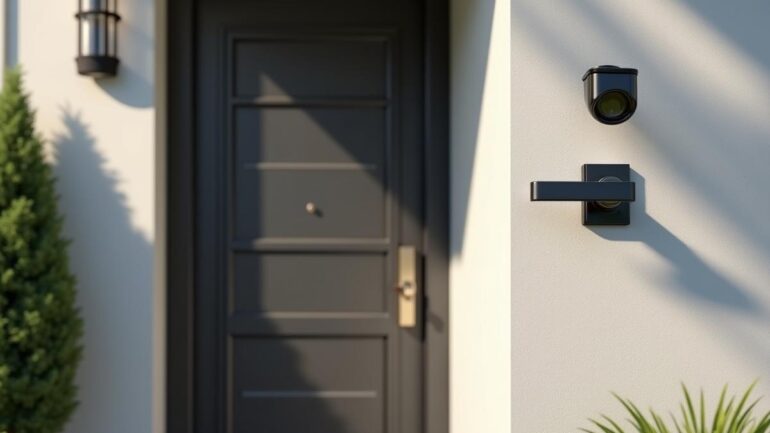Many homeowners overlook crucial aspects, leading to common home security mistakes every day. It can feel like you’ve checked every box by installing locks, setting up a camera, and leaving the porch light on at night. Yet small oversights slip in, opening the door to vulnerabilities you might never suspect. A few tweaks here and there can go a long way and keep your family safe without breaking the bank.
Sometimes it’s the simplest oversights that matter. People trust a quick fix or assume technology alone will keep intruders at bay. This mindset overlooks the combination of habits and physical barriers that strengthen security. Each household is unique, yet many tend to overlook similar factors involving lighting, entry points, and daily routines.
Neglected outdoor lighting invites trouble
Light can deter unwanted visitors, but it’s often overlooked or used only sporadically. Relying on a motion sensor that rarely kicks in, or a single front porch light, can leave large portions of your property in darkness. This lack of consistent illumination offers ample hiding spots for anyone scoping out your home. Ensuring each corner of your yard has some level of visibility gives fewer dark spaces for an intruder to linger.
Outdoor lighting isn’t just a matter of placing flood lamps by the garage. Sometimes the side yard, backyard, or even that narrow corridor between structures doesn’t get the same attention. Considering light timers or strategically placed solar lights can quickly cover these blind spots. It’s a small cost for a big boost in security.
Common oversights with smart locks
Some homeowners rush to adopt smart locks, hoping that a modern gadget will solve every issue. Advanced digital deadbolts help streamline entry, but they also require occasional updates and checks. Bluetooth or Wi-Fi connectivity can fail if the lock’s battery is low, or if your network has spotty coverage. Regular software updates or firmware checks are easy to skip, yet crucial to avoid glitchy locks that might inadvertently unlock.
Pairing a smart lock with a reliable door reinforcement kit helps keep intruders out. Reinforcement plates and sturdy strike plates add an extra layer of difficulty for anyone attempting forced entry. When combined with a well-maintained digital solution, the lock system stands stronger. It’s worth the extra effort to confirm your new technology isn’t creating new vulnerabilities.
Forgetting to set the monitored alarm system
It’s surprising how often people invest in a monitored alarm system yet forget to activate it. This system could be tied to a professional monitoring service or an app on your smartphone. The oversight often happens during the day if you’re running errands and think you’ll “be right back.” That small window might be the exact time an intruder decides to strike.
Routine is everything. Make a habit of activating your home alarm system each time you leave, even for short trips. Some systems let you set up auto-reminders if you walk a certain distance from your home. When these notifications pop up, they serve as gentle nudges to secure your property without hassle.
Skipping internal motion detectors
Many modern setups rely on door and window sensors but skip indoor motion detectors. While perimeter sensors are valuable, layering them with internal detectors can detect a different avenue of entry. This dual approach ensures that if someone bypasses a window sensor, they still trip an alarm moving around inside. It’s another layer that catches intruders off-guard when they think they’re in the clear.
Motion detectors also help you see if a pet or child wanders into areas they shouldn’t. Some might fear false alarms with a pet in the house, but certain devices filter out small movements. It might take a bit of trial and error to calibrate them, yet the peace of mind often outweighs the initial setup challenge.
Lax window security can sabotage everything
Windows are common targets for break-ins, yet homeowners often treat them as afterthoughts. A thick curtain might dissuade casual observers, but it won’t hinder someone determined to lift an unlocked window or break aging glass. Installing secure window locks or upgrading to impact-resistant glass makes a difference. A second-story window that’s easy to climb to is just as vulnerable as a ground-level one.
If your neighborhood has seen a rise in burglaries, do a quick inspection of each window. Check for rotting frames or loose hardware, and consider adding a sensor that pairs with your main alarm system. Deviating from the obvious entry points can be an intruder’s strategy, so your windows deserve equal attention as your doors. A sturdy approach on all fronts ensures fewer gaps for criminals to exploit.
Overlooking garage entries and interior doors
The garage often houses expensive tools, bikes, and additional entry points directly into your living spaces. It’s easy to let your guard down if you arrive home tired and forget to lock the garage door. Some even leave interior doors from the garage to the house unlocked, trusting that the main garage door is enough. That single oversight can grant immediate access to an intruder if they find a way in.
Securing your garage involves more than locking the main door. A secondary deadbolt on the interior door can thwart a quick intrusion. If you use a code-based garage opener, change the code regularly or use a device that can encrypt signals. Routine checks and minor tweaks keep the garage from becoming a security risk.
The risk of leaving valuables visible
It’s tempting to stash sports gear or power tools in plain sight when you’re in a hurry. But visible valuables rolling around in the garage or parked car can tempt opportunistic thieves. A quick peek through a window or garage door gap could reveal items worth stealing. Maintaining a clutter-free space and storing valuables out of sight is a simple deterrent.
When you must leave items in the garage, covering them or using locked cabinets can help. Organized shelves that hide pricey equipment behind doors or curtains reduce the risk of a smash-and-grab scenario. Thieves often choose the easiest option, so removing temptation from their view increases your odds of staying safe.
Relying on DIY home surveillance without maintenance
Setting up a camera network on your own can save money. You get to customize your angles and connect your phone for remote viewing. Yet many people install cameras, then forget to clean the lenses or check if each feed is still functioning. Harsh weather, software updates, or Wi-Fi issues can incapacitate a camera without you noticing.
Regular checks keep cameras doing their job. Schedule monthly or quarterly reviews of recorded footage. Look for fuzzy images, dark spots, or offline equipment. Sometimes a simple update to the camera’s app or firmware addresses performance issues. If you skip these steps, your system may fail just when you need it most.
Ignoring digital threats to your security systems
Smart home devices often open digital backdoors if you don’t safeguard them. Intruders aren’t always sneaking around bushes; some try hacking into wireless systems or cracking weak passwords. Overlooking these risks can make you vulnerable without an intruder ever setting foot on your property. Regularly changing passwords and enabling two-factor authentication might sound tedious, yet it’s essential.
Secure your Wi-Fi network by using strong encryption and a unique password for your router. Limiting remote access to only the necessary devices also reduces exposure. Keeping all your apps and system firmware updated is a defensive move against new hacking methods. Digital layers are now part of physical home security, so giving them attention keeps your defenses balanced.
Failing to log out of shared apps
Sometimes multiple household members have access to your home’s security app. If one person forgets to log out on a lost phone, that’s an invitation to rummage through camera feeds or unlock doors remotely. It’s wise to manage permissions and remove any old devices that no longer need access. This step cuts down the risk of letting someone exploit leftover logins.
Dismissing friendly community watch strategies
Many people overlook the simple power of a watchful neighbor. You might exchange greetings but never coordinate to watch each other’s homes. This sense of community can catch unusual activity when you’re out of town, working late, or just not paying attention. Creating a basic network of trusted neighbors who alert each other to suspicious cars or strangers walking around is a top-notch, low-cost security layer.
When traveling, ask a neighbor to pick up your mail or move your trash cans back from the curb. These small tasks make it seem like you’re actively present, discouraging anyone scouting for vacant homes. It also fosters stronger community ties, which naturally discourages crime in the area. People who collaborate can spot and stop threats more readily.
Poor upkeep of locks and alarm systems
Door locks and alarm systems aren’t plug-and-play forever. Parts wear out, batteries drain, and technology evolves. A lock that sticks today might fully jam or fail to latch tomorrow. Keeping an ear out for strange noises or signs of corrosion isn’t only about convenience, but also about ensuring your home remains secure.
Regular lock lubrication and battery swaps for sensors help maintain smooth operation. Checking your alarm system for error messages is often overlooked when life gets busy. Even if the system still arms and disarms, subtle faults can reduce reliability. A little maintenance can extend the life of your hardware and keep your home safer in the long run.
Skipping backups for power outages
All that technology becomes useless during a power outage if you don’t have a backup plan. Some systems come with battery backups, but they might only last a few hours if you forget to replace old batteries. A short outage might seem harmless, yet some criminals watch for these moments of weakness. Consistent power backups and regular testing of them close this security gap.
A simple shift in mindset
Taking a couple of small steps now can prevent large problems later. Fresh batteries, updated software, and consistent habits often stand between you and the next attempted break-in. The biggest challenge isn’t usually cost or time; it’s remembering to check the details you tend to ignore day after day.
Homeowners who pay attention to little details and stay vigilant often find they don’t need massive overhauls to protect their homes. Rethinking your approach doesn’t mean turning your house into a fortress. It means refining your methods and making small, steady improvements year-round. These measures reduce your chance of falling victim to a crime while helping you sleep a bit easier.





